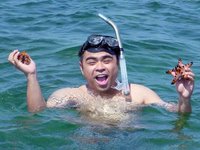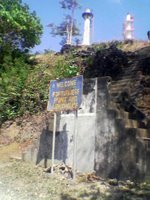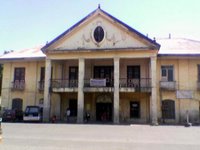 Going back to Manila from Bolinao, people rarely take the Zambales route obviously because it's longer. But you are missing a lot if you've never passed this road. Indeed, it provides one of the best views of the Philippine countryside as well as the beaches along the South China Sea. So if you have a lot of time to spare and extra funds for gas, I suggest you give it a try.
Going back to Manila from Bolinao, people rarely take the Zambales route obviously because it's longer. But you are missing a lot if you've never passed this road. Indeed, it provides one of the best views of the Philippine countryside as well as the beaches along the South China Sea. So if you have a lot of time to spare and extra funds for gas, I suggest you give it a try.From Bolinao, I was planning to pass by Alaminos again to try the quarterpounder at McDonald's which many of my brods claim is the best they've tasted. On the way, I was curious to take a look at the island municipality of Anda which could be accessed by a long bridge somewhere between Bolinao and Bani. Except for the view from the bridge and the white sand beach of Tondol, nothing much to see in Anda. So on I went.
 For some reason, I missed the turn to Alaminos and ended up in the faster route to Zambales. I guess it was a blessing in disguise. From Bani, I passed by Agno, Burgos where I took photos of the Gabaldon school building, Dasol which was a salt producing town, and finally the last town of Pangasinan, Infanta. All these towns were by the beach and there were a lot of small resorts along the road. Imagine the potential of these pristine beaches!
For some reason, I missed the turn to Alaminos and ended up in the faster route to Zambales. I guess it was a blessing in disguise. From Bani, I passed by Agno, Burgos where I took photos of the Gabaldon school building, Dasol which was a salt producing town, and finally the last town of Pangasinan, Infanta. All these towns were by the beach and there were a lot of small resorts along the road. Imagine the potential of these pristine beaches! The first town upon entering Zambales was Sta. Cruz. I was pleasantly surprised to see so many old houses still intact, in fact they lined-up along the streets one after the other. And the coral Church of St. Michael the Archangel was just perfect (except for the modern interior). Although the houses were neglected, if restored properly, Sta. Cruz has potential of becoming another heritage town and a showcase for Zambales. Which is why I immediately contacted Vice-Governor Ramon Lacbain II, who is a SSEAYP alumnus like myself, to check if he was in town. Great! He was free to meet me in Olongapo City.
The first town upon entering Zambales was Sta. Cruz. I was pleasantly surprised to see so many old houses still intact, in fact they lined-up along the streets one after the other. And the coral Church of St. Michael the Archangel was just perfect (except for the modern interior). Although the houses were neglected, if restored properly, Sta. Cruz has potential of becoming another heritage town and a showcase for Zambales. Which is why I immediately contacted Vice-Governor Ramon Lacbain II, who is a SSEAYP alumnus like myself, to check if he was in town. Great! He was free to meet me in Olongapo City.
 The next stop, actually one of the main reasons I took the Zambales route, was Masinloc. Its church was declared a national cultural treasure in 2001. But when I got there, all the doors were locked since the structure is currently being restored by the NHI. A personal disappointment since I did not get to see the interior but very good news for heritage. After all that bad news I saw in Pangasinan, here was a perfect example of the proper management of a heritage church. The formula is simple, get techinical support from the experts! What's wrong with asking for help from those who know what to do? In the government, you have the NCCA, National Museum and the NHI. From the private sector, you have groups like the Heritage Conservation Society.
The next stop, actually one of the main reasons I took the Zambales route, was Masinloc. Its church was declared a national cultural treasure in 2001. But when I got there, all the doors were locked since the structure is currently being restored by the NHI. A personal disappointment since I did not get to see the interior but very good news for heritage. After all that bad news I saw in Pangasinan, here was a perfect example of the proper management of a heritage church. The formula is simple, get techinical support from the experts! What's wrong with asking for help from those who know what to do? In the government, you have the NCCA, National Museum and the NHI. From the private sector, you have groups like the Heritage Conservation Society. Thumbs up to the Masinloc's San Antonio Church Restoration Volunteers headed by Fr. Ernie Raymundo, which is currently raising counterpart funds from citizens of the town. I also commend Sen. Aquilino Pimintel for releasing P4.76 million from his CDF to fund the restoration of this 1607 church which was badly damaged in a December 1999 earthquake. For those who want to donate funds, you can call telephone no. (63 47) 8215678.
 It was getting dark and I still had two churches to visit. It was another 45 minutes from Masinloc to the provincial capital Iba, which is the birthplace of former president Ramon Magsaysay. There are a lot of old houses around but I didn't have much time to explore so I just took photos of the1703 Cathedral of St. Augustine, the seat of the Diocese of Iba. The current bishop, the Most Rev. Florentino G. Lavarias, D.D. was a former parish priest in San Fernando, Pampanga.
It was getting dark and I still had two churches to visit. It was another 45 minutes from Masinloc to the provincial capital Iba, which is the birthplace of former president Ramon Magsaysay. There are a lot of old houses around but I didn't have much time to explore so I just took photos of the1703 Cathedral of St. Augustine, the seat of the Diocese of Iba. The current bishop, the Most Rev. Florentino G. Lavarias, D.D. was a former parish priest in San Fernando, Pampanga. A few minutes away was Botolan. It was quite dark but I was able to get a shot of the small coral Church of Sta. Monica. It was then that I realized that I had not eaten at all! I guess I was just too excited with my trip. So I stopped over at one of the towns to rest when I saw a Mister Donut sign as well as an internet shop. It turns out, it was San Narciso, which breaks were quite popular among surfers.
A few minutes away was Botolan. It was quite dark but I was able to get a shot of the small coral Church of Sta. Monica. It was then that I realized that I had not eaten at all! I guess I was just too excited with my trip. So I stopped over at one of the towns to rest when I saw a Mister Donut sign as well as an internet shop. It turns out, it was San Narciso, which breaks were quite popular among surfers.To make the long story short, I reached Olongapo at 8 p.m., close to five hours after I had left Bolinao! So it was straight to Sam's Pizza where the vice-governor was waiting for me. The chicken teriyaki pizza I ate was great. We were able to tackle a lot for tourism in Zambales. I'll let you know about the plans when they've all been firmed up. But definitely, the plans are exciting and grand. I got back in Pampanga at 1 a.m.
Time for me to rest now. I'm flying to Cebu at 7 a.m. tomorrow. Yipee! Another whirlwind adventure, this time in Central Visayas. I plan to visit five provinces in six days. Hehe! I hope I make it to all.
















